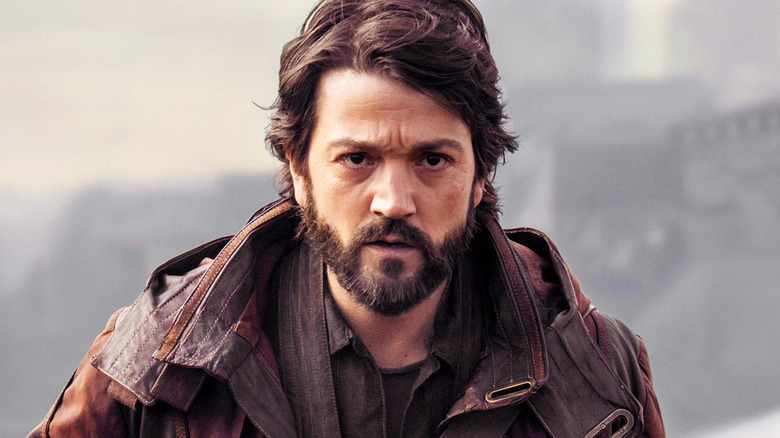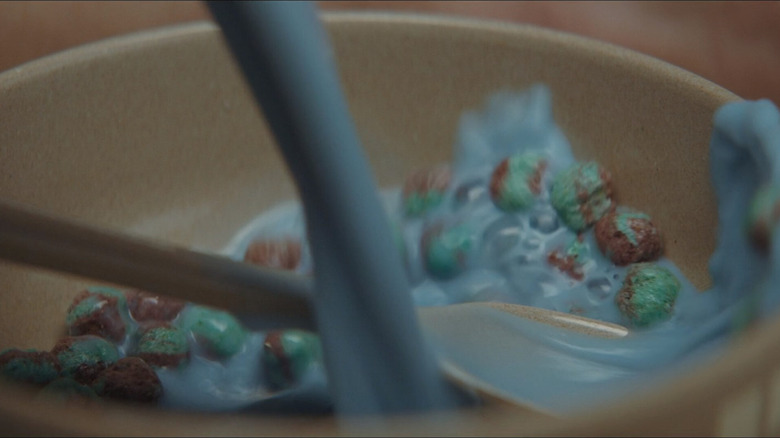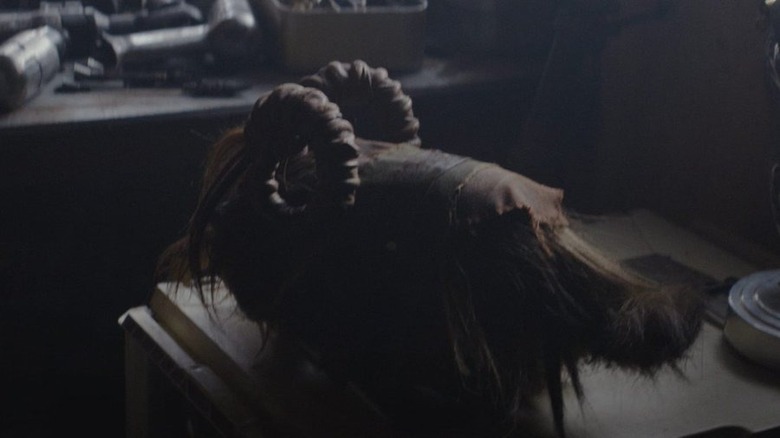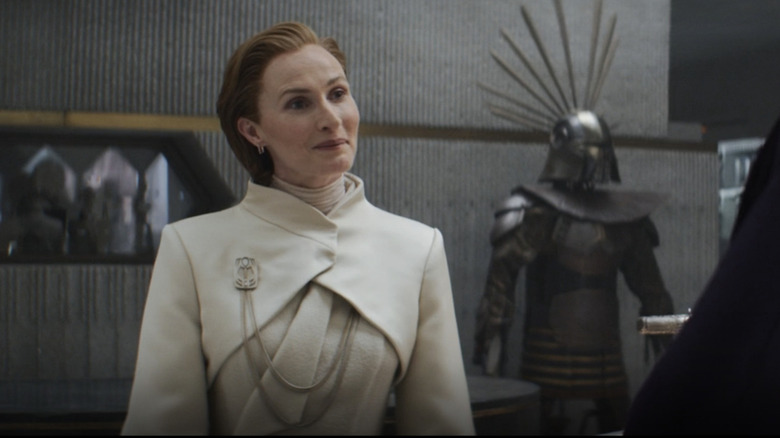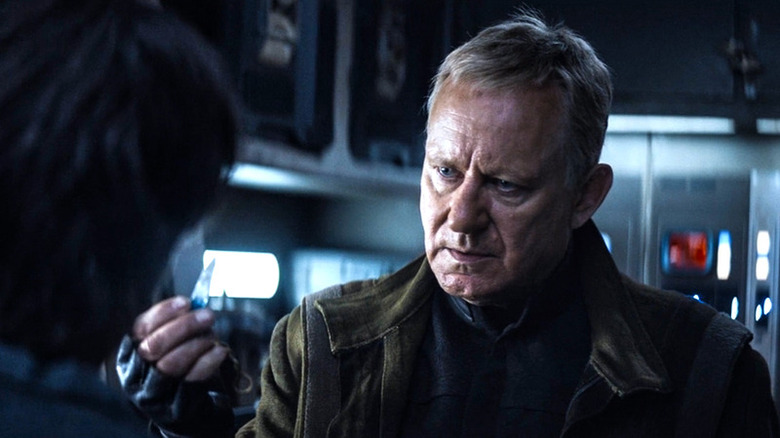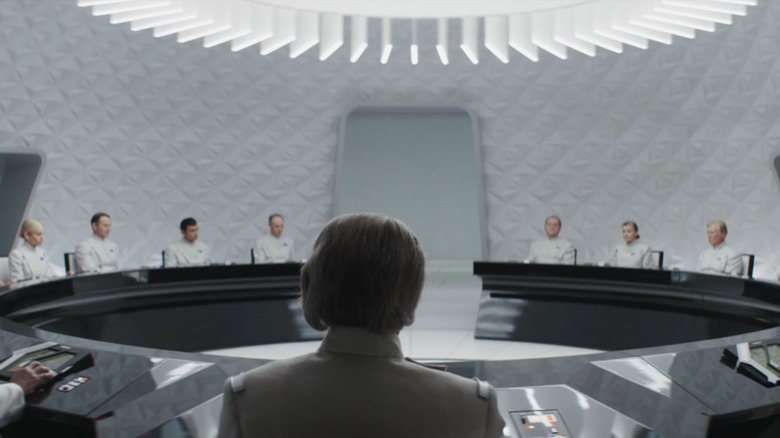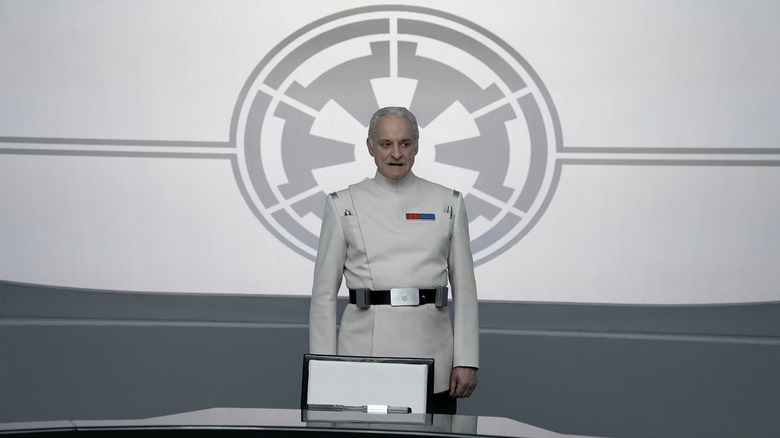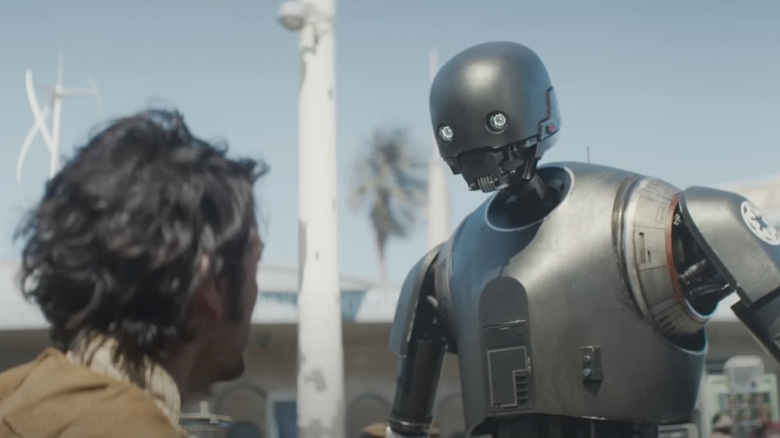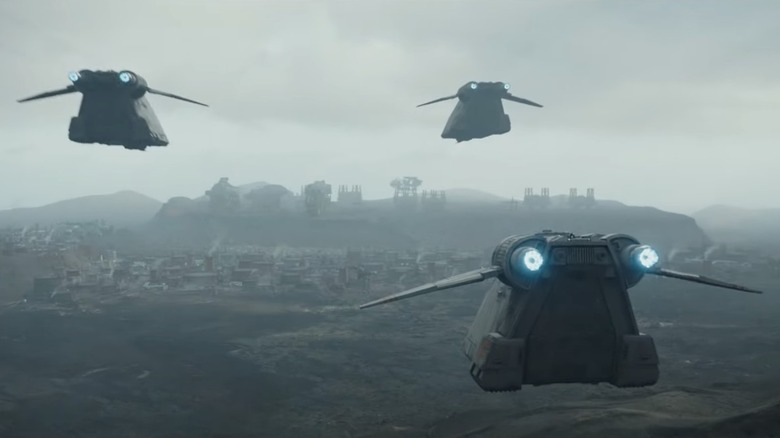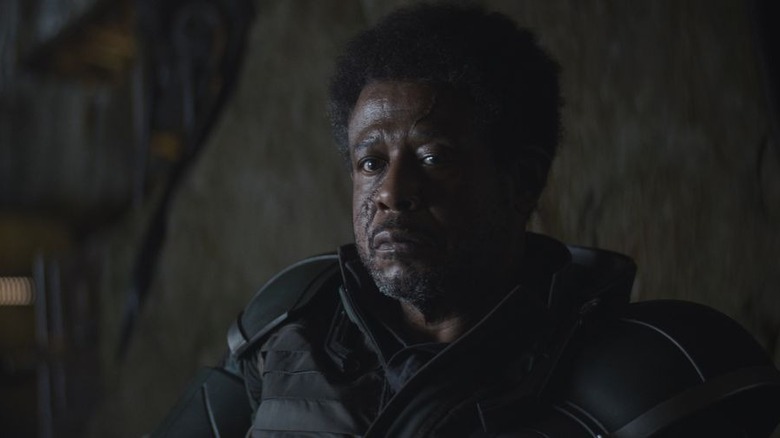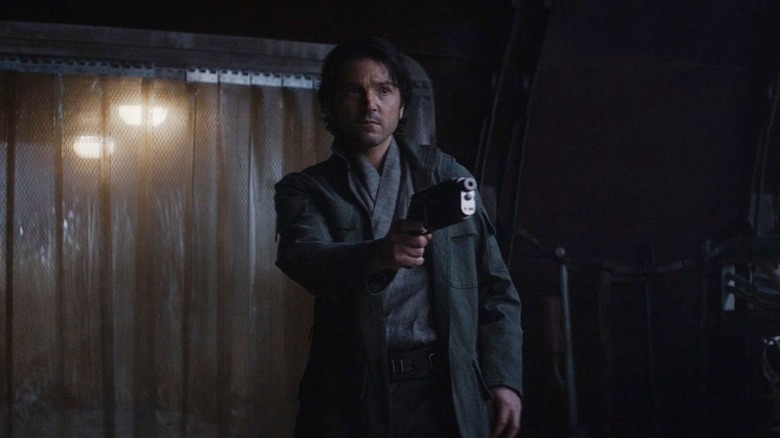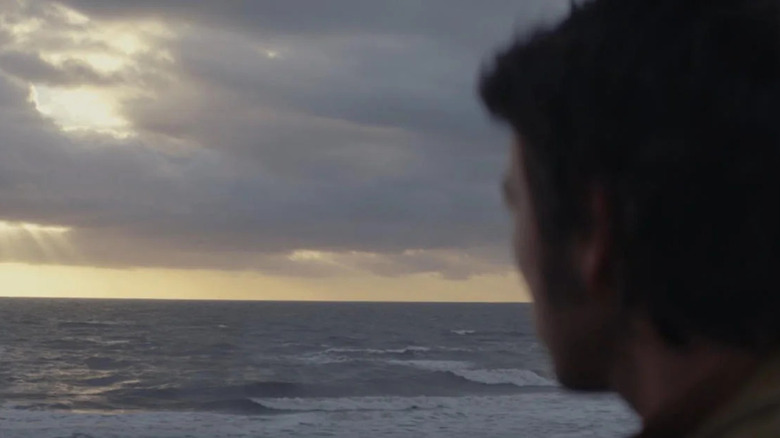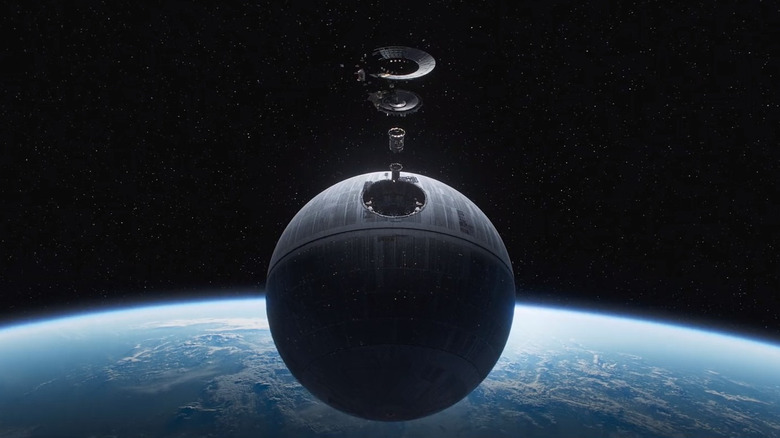The 12 Best Star Wars Easter Eggs In Andor Season 1
Spoilers for season 1 of "Andor," including the finale, follow.
Of all the Star Wars shows that Disney announced, "Andor" was the one that nobody was excited about. It's a prequel about a character from a spin-off film who — spoiler alert! — dies at the end of the movie. There is literally nowhere for this character to go; traveling to his past feels like, well, going backwards. And yet, "Andor" features some of the best storytelling we have ever gotten from Star Wars. It is grounded and gritty, with nary a Jedi in sight. It is glorious.
One of the worst things about modern Star Wars is just how self-referential the franchise has become. In-your-face cameos and clumsy fanservice is the norm, often coming at the expense of the overall story. Fortunately, "Andor" bucks this trend, going out of its way to not give us the cinematic equivalent of, "Hey, remember this?" Despite this restraint, "Andor" still has tons of neat references to other Star Wars stories. It just doesn't beat you over the head with them; if anything, they're easy to miss. So, we've assembled the best of the best for your enjoyment.
Blue milk
The milk in a galaxy far, far away has fascinated fans since we first glimpsed it in Luke Skywalker's kitchen. That OG milk was blue — that's what Aunt Beru had on hand, anyway — and then "The Last Jedi" introduced a green variant into the fold. It's hard to say what people hated more: the bright new hue, or the relish with which Luke drank it straight from the hairy tap.
In any case, blue milk makes its triumphant return in "Andor." After he's fired for gross incompetence, aspiring fascist Syril Karn (Kyle Soller) returns to his childhood home. While badgering him and being a passive aggressive nightmare, his mom feeds him the Star Wars version of Fruit Loops. The bright blue milk makes the cereal look all kinds of wrong, like it's been filtered through a net woven from raspberry Sour Patch Kids. Maybe Luke was onto something, is what I'm saying.
Cassian's stuffed bantha
Much like Baby Yoda, the stuffed bantha is the toy you didn't realize you wanted, and we suspect that Disney will prove itself woefully unprepared for the demand — just in time for the holidays, too! Seriously, though, banthas have always had a shaggy sort of charm, but did you ever realize that they could be so gosh darn cute? Thanks to "Andor," we do now.
In episode 2, Maarva Andor (Fiona Shaw) wanders into her son Cassian's (Diego Luna) room. His bed is unmade and spare parts cover a workbench. The cutest little bantha ever sits on a makeshift nightstand right next to the bed. It's the only sign that Cassian was ever actually a boy at all — by his own admission in "Rogue One," he's been in this fight since he was six years old. That doesn't leave much room for play. Still, it's telling that the toy is stored in such an obvious place, instead of being shoved into a drawer or under the bed. It's a neat bit of character building, as it invites questions that will never be answered. That's okay. As seems to be the case in "Andor," a few subtle implications do quite a bit of heavy lifting all on their own.
The relics in Luthen's shop
Luthen Rael's (Stellan Skarsgård) shop is a cornucopia of delights. Not only do the scenes in the store feature Luthen at his best — there, he's either serving as the calculating but conflicted leader of the rebellion or playing the smarmy collector — but they also include all sorts of background candy for observant viewers. This piece could've easily been called "The 12 best Easter eggs in Luthen's shop." But in the interest of variety, we're (reluctantly) limiting ourselves to this one section.
If you pause "Andor" during any scene inside the shop, you're practically guaranteed to see something exciting — and, perhaps, familiar. Jedi holocrons, a wicked set of armor from the video game "The Force Unleashed," and something that looks an awful lot like the Sankara Stones from "Indiana Jones and the Temple of Doom" are just a few examples. But our favorites are callbacks to past Star Wars films, such as a Gungan energy shield, one of Padme's elaborate headpieces, and Plo Koon's elongated breathing mask.
Kyber crystal
Interestingly, the mystical crystal that powers lightsabers — aka the greatest weapon pop culture has ever imagined — fulfills much the same function in "Andor" as it does in "Rogue One." In the film, Jyn Erso (Felicity Jones) wears a kyber crystal necklace that was given to her by her father, Galen (Mads Mikkelsen). The gem ends up being quite the conversation starter, as the blind quasi-Jedi Chirrut Îmwe (Donnie Yen) notices it and eventually ends up accompanying Jyn on her quest. Without Chirrut's remarks about the crystal, Jyn would've dismissed him as a mystical quack trying to cheat her out of credits. In other words, Jyn's choice of neckwear likely saved the galaxy.
The Kyber necklace in "Andor" doesn't have quite the same kind of cachet, but it's no less important. In order to secure Cassian's help with the mission on Aldhani, Luthen gives him a kyber crystal necklace as a retainer. According to Luthen, it's worth 40,000 credits, but it's worth much more than that to him. It's unlikely that Luthen is planning on using that crystal to kickstart his own Jedi order, but you never can tell. His plans have plans. Could the crystal have powered that nifty move where he sliced two TIE fighters in half with what looks like a giant space lightsaber? Probably not, but maybe.
Name-dropped planets
George Lucas was fond of dropping the names of places and events without intending to explain or explore them. It's a narrative technique that makes the Star Wars universe feel larger and more real, like it has an actual history. We heard about the Clone Wars and the Kessel Run in "A New Hope," but for over 20 years we didn't have any clue what they actually were. I'm still waiting to see Lando's little maneuver at the Battle of Taanab, which impressed Admiral Ackbar so much that he immediately promoted Lando to general.
Many planets are named during "Andor," particularly during the Imperial Security Bureau staff meetings. Some are places we've never heard of before, but amid the general mumbo-jumbo, the familiar stands out. There's talk of a setback on Scarif, the planet from "Rogue One" where Cassian is fated to die. Jakku and Hosnian Prime, places we visit in "The Force Awakens," are suspected hotbeds of rebel activity. Even some planets from the original trilogy get a shout-out. There's a mention of Ord Mantell — Han Solo talks about running into a bounty hunter there in "The Empire Strikes Back" — and another reference to Kessel. That planet sure is spicy.
Wullf Yularen
This one is more of a deep cut, but it absolutely earns its place on this list given how often this character has popped up in Star Wars lore. Wullf Yularen (Malcolm Sinclair) has been a part of Star Wars since Star Wars has been a thing. He served under Grand Moff Tarkin aboard the Death Star, and listened passively as his boss announced that the Emperor had disbanded the senate. However, given that he was a literal background character with no lines — and that he dies when the Death Star is destroyed — this would be a rather lame Easter egg if this was the only time we'd ever seen Yularen. But that's not the case.
Yularen features quite prominently in the animated Star Wars projects, including "The Clone Wars" movie and "The Clone Wars" and "Rebels" TV shows. Interestingly, early in the timeline, Yularen is one of the good guys, serving the Republic alongside Anakin Skywalker. He's the most prominent Republic officer that we meet. He also pops up in episode 7 of "Andor" as an ISB agent, having remained with the Republic as it transitioned into the Galactic Empire. Perhaps he did so out of a sense of duty, but maybe he just can't quit Anakin.
K-2SO look-alike
The best Easter eggs are the ones that are familiar yet surprising. Fans of "Rogue One" were no doubt delighted when a familiar face appeared in "Andor" episode 7 even though, logically, it couldn't be our beloved K-2SO (Alan Tudyk). Even if it somehow was the exact same robot — which would really be a stretch, given how "Andor" goes out of its way to avoid such narrative conveniences — it obviously wouldn't know Cassian. Nonetheless, we still feel surprised when the security droid throttles Cassian, nearly killing him.
But we really shouldn't have expected this random security droid to act any differently. There are probably millions of KX-series droids across the galaxy, and they're all wearing K-2SO's face. It's no different than how every protocol droid is C-3PO until proven otherwise. Still, the whole episode is amusingly ironic, especially given how flippant K-2SO is about killing people. Apparently, that's just part of its programming.
Ship cameos
While Star Wars' penchant for character cameos has been an increasingly prevalent — and in the opinion of this writer, unwelcome — part of the saga since the prequel trilogy, the reappearance of technology from older films is always a welcome reminder of what came before. Having Cassian literally bump into Ponda Baba and Cornelius Evazan, the two goons from "A New Hope" who give Luke a hard time in the Mos Eisley cantina, only serves to make the universe feel smaller. Mass-produced pieces of technology like ships or droids, however, give us the same jolt of recognition with no negative trade-offs.
Throughout "Andor," we glimpse several ships that originated in the films. There is a Y-Wing in the scrap yard where Cassian hides out. There are two X-Wings parked outside of Saw Gerrera's (Forest Whitaker) base, which itself has strong Yavin vibes. Much like in "The Force Awakens," our heroes run toward a quadjumper, hoping to use it to get off-planet (ironically, it turns out the quadjumper is a garbage ship, too). Perhaps the best cameos, though, are the Republic Gunships we see in Cassian's flashback. Not only do the ships just look cool, but they're actually flying around!
Saw Gerrera
What's the difference between an Easter egg and a cameo? In this case, they're one in the same. In "Andor," Forest Whitaker reprises the role he played in "Rogue One," and while it's not necessarily a surprise to see Saw pop up, this version of the character is pleasantly unexpected. The guy we meet in "Rogue One" is literally half a man. He hobbles around on cybernetic limbs, taking liberal hits off an oxygen tank. Worse yet, he's suspicious of everyone, and thinks nothing of inflicting unwarranted cruelty. He's a sad, broken man. You kind of understand why he decides to meet his end with his arms wide open.
In "Andor," Saw has yet to be crippled by war or to be driven paranoid by years of guerilla assaults on the Empire. It's actually quite refreshing to see what Saw was before the war broke him. Now, you understand why this guy was such a magnetic figure in the pre-Rebellion era. This version of Saw hasn't developed his cynical edge yet, either. He's horrified by the idea that Luthen could let fellow rebel Anto Kreegyr — and 30 other men — walk into a trap. The cold logic makes sense, but the human cost stuns Saw.
Andor shoots first, always
This one is perhaps the least Easter-eggy entry on the list, but it harkens back to a controversy that has been brewing in the Star Wars fandom since George Lucas released the Special Edition of "A New Hope" in 1997. In the original cut of the film, Han Solo kills Greedo in cold blood. The scene was an eye-opener, especially since we'd met Han only minutes before. It firmly established Han as someone who was willing to do anything in service of self-preservation, and it set him up for a rousing redemption arc. Unfortunately, most of that mojo was lost thanks to Lucas' clumsy edits, which made Greedo's murder an act of self-defense. Hence, the fierce rancor.
Cassian exhibits the same mentality as old-school Han. Like Han, we first see it moments after meeting Cassian in "Rogue One." "Andor" turns back the clock and shows us who Andor was before the Rebellion. As it turns out, he's still the guy who shoots first. He does it in episode 1, taking out the Pre-Mor officers who make the mistake of trying to shake him down. He does it again after Avrel Skeen (Ebon Moss-Bachrach) suggests they split the proceeds from the heist and take off. "Andor" has only reaffirmed that Cassian is the guy we met before, and doubles down on his drive to survive no matter what.
Death on a beach
One of the most direct references to "Rogue One" in "Andor" comes in episode 11. After escaping the Imperial work prison, Cassian and one other prisoner — out of 5000! — manage to sneak off-planet aboard a rickety old quadjumper. Cassian returns to Star Wars: Cancun to retrieve his go-bag and calls home to pass on a message to his mom, only to learn that she passed away.
Shocked and grief-stricken, Cassian stands on the beach, looking at the sunset. The scene faintly evokes the binary sunset seen when young Luke contemplated his bleak future as a moisture farmer. The stronger connection, however, is to the ending of "Rogue One," as the specter of death hangs over both scenes. After successfully stealing the Death Star plans, Cassian and Jyn Erso embrace on a forlorn beach, watching the sun go down as the planet is destroyed around them. This scene in "Andor" is a powerful reminder of where Cassian's path ends.
The Death Star
The trifecta: a post-credits scene, a cameo, and an Easter egg all in one. Season 1 of "Andor" concludes with our first post-credits anything — up until this point, the series hasn't even given us the beautiful concept art that accompanies the credits to "The Mandalorian"— and it's a doozy. That the Death Star is being constructed is no surprise to anyone with a passing familiarity with Star Wars. The original trilogy gave us two Death Stars, after all, and the shiny new space weapon also features prominently in "Rogue One." This isn't even our first Death Star post-credits scene! Fans may recall that "Revenge of the Sith" ends with the Axis of Evil — Emperor Palpatine, Darth Vader, and Grand Moff Tarkin — looking on in silent appreciation as the familiar structure takes shape.
However, the surprise appearance of the Death Star in "Andor" rates as an Easter egg in part because of these earlier scenes, and in part because it's hiding in the credits. After 11 episodes, we've now become accustomed to closing Disney+ once the credits appear. There is something else at play, however. The Death Star acts both as a silent reminder of where this story is going, and a promise that season 2 of "Andor" will pivot substantially from the tenor and tone of season 1. The first season explored Cassian's backstory and fleshed him out as a character. Next season, we'll get to see the guy who was all about the Rebellion. Hinting at that with a Death Star appearance is the perfect way to cap off an incredible season.
